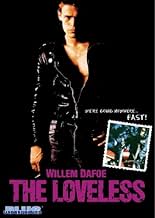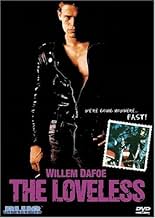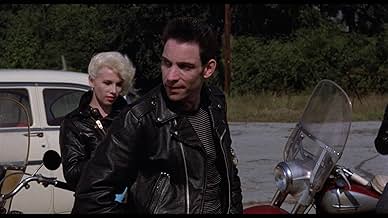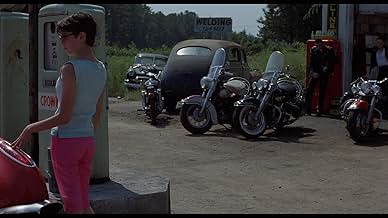VALUTAZIONE IMDb
6,1/10
3478
LA TUA VALUTAZIONE
Iniziano i problemi quando un club motociclistico si ferma in una piccola città del sud prima di dirigersi alle corse di Daytona.Iniziano i problemi quando un club motociclistico si ferma in una piccola città del sud prima di dirigersi alle corse di Daytona.Iniziano i problemi quando un club motociclistico si ferma in una piccola città del sud prima di dirigersi alle corse di Daytona.
- Regia
- Sceneggiatura
- Star
Tina L'Hotsky
- Sportster Debbie
- (as Tina L'hotsky)
Recensioni in evidenza
Kathryn Bigelow's first feature, as well as Willem Dafoe's first credited role. Dafoe plays a 1950's biker who rolls into a small Georgia town en route to Daytona and meets up with some biker friends. The locals treat them with a mixture of fascination and contempt. But this isn't EASY RIDER or THE WILD ONE... its moody atmosphere plays more like a meeting of Kenneth Anger and David Lynch. Eerie bright colors, an aura of sleazy cool, homoerotic imagery, long lingering shots, smoky score and hip soundtrack. I found it fascinating and it unexpectedly drew me into its world. Some of the performances are weak and some of the writing is corny, but ultimately these flaws just add to the sense of iconography at play, a kind of mythical recreation of archetypes from another time. These characters (both the bikers and the townsfolk) are indeed "loveless", living without drive, detachedly picking up cheap kicks wherever they can. I really enjoyed watching this stylish, elegiac film.
"The Loveless" has apparently built somewhat of a cult since it was first released more than thirty years ago. To a degree, I can sort of understand that. There are some positive things to be found here. Though a low budget movie, the movie looks good, from the convincing period detail to the photography. The acting is also well done; you can really believe these brooding characters. And the atmosphere is appropriate for a movie about hard core bikers.
Unfortunately, despite positive things like what I've listed, the movie didn't work for me. In fact, I think that most viewers will be dissatisfied as well. There is a big problem, and that problem is that there is virtually no plot. The movie is just one scene after another where little to nothing (usually nothing) of consequence happening. I admit I came close to hitting the eject button on my DVD player several times because I was quite frankly bored. In the end, I can only recommend the movie to hard core fans of anyone in front of or behind the camera.
Unfortunately, despite positive things like what I've listed, the movie didn't work for me. In fact, I think that most viewers will be dissatisfied as well. There is a big problem, and that problem is that there is virtually no plot. The movie is just one scene after another where little to nothing (usually nothing) of consequence happening. I admit I came close to hitting the eject button on my DVD player several times because I was quite frankly bored. In the end, I can only recommend the movie to hard core fans of anyone in front of or behind the camera.
Now that this beautifully sculpted, wildly atmospheric, true-to-the-era in which it is set movie is on DVD, I've watched and re-watched it many times. This is more of a review of the DVD than of the whole film, and the spoilers are more DVD commentary-related than plot-related, so read on if you wish.
This is, by far, one of the finest films paying homage to the motorcycle enthusiasts (or outlaws, as it may be), settings, and characters of the 1950's that I've ever seen, and I own many, so any rockabilly guys or gals out there reading this review - this movie is for you! It's moody, sexy, violent, and slick - great eye-candy with an outstanding cast of characters.
The DVD has one of the better commentaries, featuring conversations with the film's co-writer/co-directors Kathryn Bigelow & Monty Montgomery, as well as the film's star, Willem Dafoe. Dafoe credits the movie's directors for starting his career with this movie, a fact which Monty Montgomery humbly shrugs off. They get into the movies they watched that directly influenced how "The Loveless" was shot, trivia notes, like how Robert Gordon, who was paid to score the flick blew all of the budget on on single calypso tune that is featured for a few minutes of the film. It would also seem that Gordon, who is most noted for being a rockabilly musician (and an excellent one at that!) was inadvertently cast while meeting with the film's directors. Gordon created some on-set tension that flickered mainly between himself and Dafoe, as Gordon felt that he was the only one on set who truly understood the whole biker/greaser world.
It is interesting to note that the movie was Bigelow's thesis for film school, as well as her directorial debut, and it must've earned her some high marks, as she's gone on to work with people like David Lynch! Montgomery, too, has worked extensively with Lynch, producing "Wild At Heart", working on "Twin Peaks", and acting in "Mulholland Dr."
For those who expect this to be a biker exploitation flick (like "The Wild One" and all of its followers thereafter), you're in for a surprise. The directors intended for the audience to feel as if that is what they were in for while the initial scenes unfold, but as the story moves forward, we realize that it isn't so much a biker film but more of a kind of a wild-west movie. Monty Montgomery credits Edgar G. Ulmer's short, noir film "Detour" as being the major influence as far as the style, the framing, and the shots of "The Loveless" go. He also credits Kenneth Anger's movie "Scorpio Rising" as the movie that inspired the whole homo-eroticism of the biker world as presented in this, Montgomery's earliest film.
For those interested in some trivia, here ya be - Originally titled "U.S. 17", which used to be a U.S. superhighway up until the 1960's when the I 95 highway replaced it as the major thruway from Georgia to Florida and up to New York, the entire film is shot on location along this now abandoned stretch of blacktop. Monty Montgomery, the movie's co-director, grew up in and around the Georgia area where the film was shot, and at the time of filming, the stretch of road was like a time capsule, with abandoned motels, diners, and gas stations along the way which had not changed since the 40's and the 50's. This made the reality of the movie much easier to capture, and cut down massively on the cost of what would have meant sound stage creations of all of these types of locations. I wonder if any of these places exist now, as the movie was done at the beginning of the 80's? I can only hope...
There is no disguising that this film focuses more on atmosphere than on plot, and there is no pretense to suggest that the directors intended anything else. Montgomery even refers to it as "eye-candy", and why not? Sometimes my eyes crave the cavities offered up by such sweet treats as "The Loveless"! There are many a long, lingering shot of beautiful vintage 'cycles being worked on, close ups on tattoos (one of the actors, Larry Matarese, who plays "La Ville", opted for an actual old-school pinup gal tattoo on his forearm before filming began), tension-creating pauses while characters look on sipping coffee in a diner or lean on a 50's Coke machine clad in leather and denim, and all of this works for the piece that this movie was meant to be.
It is somewhat of homage to "The Wild One", but only in that it deals with motorcycle enthusiast-rebels in the 50's - all other plot comparisons and similarities fall by the wayside.
Though they wished for a score that was more like Sergio Leone's large, sweeping, and melodramatic western film's scores, and they were held back by budgetary constraints, I felt what they did have to work with offered the film the nostalgic atmosphere perfectly. The score as it stands on the DVD (which, unfortunately is not on CD, record, or tape, darn it!) largely done by John Lurie (of "The Lounge Lizards" fame, and also a regular in many Jim Jarmusch films), along with a minimal amount of tracks supplied by Robert Gordon, can be credited for being the cherry on top of this 50's diner served, tasty milkshake of a flick!
~T.Paul www.t-paul.com
This is, by far, one of the finest films paying homage to the motorcycle enthusiasts (or outlaws, as it may be), settings, and characters of the 1950's that I've ever seen, and I own many, so any rockabilly guys or gals out there reading this review - this movie is for you! It's moody, sexy, violent, and slick - great eye-candy with an outstanding cast of characters.
The DVD has one of the better commentaries, featuring conversations with the film's co-writer/co-directors Kathryn Bigelow & Monty Montgomery, as well as the film's star, Willem Dafoe. Dafoe credits the movie's directors for starting his career with this movie, a fact which Monty Montgomery humbly shrugs off. They get into the movies they watched that directly influenced how "The Loveless" was shot, trivia notes, like how Robert Gordon, who was paid to score the flick blew all of the budget on on single calypso tune that is featured for a few minutes of the film. It would also seem that Gordon, who is most noted for being a rockabilly musician (and an excellent one at that!) was inadvertently cast while meeting with the film's directors. Gordon created some on-set tension that flickered mainly between himself and Dafoe, as Gordon felt that he was the only one on set who truly understood the whole biker/greaser world.
It is interesting to note that the movie was Bigelow's thesis for film school, as well as her directorial debut, and it must've earned her some high marks, as she's gone on to work with people like David Lynch! Montgomery, too, has worked extensively with Lynch, producing "Wild At Heart", working on "Twin Peaks", and acting in "Mulholland Dr."
For those who expect this to be a biker exploitation flick (like "The Wild One" and all of its followers thereafter), you're in for a surprise. The directors intended for the audience to feel as if that is what they were in for while the initial scenes unfold, but as the story moves forward, we realize that it isn't so much a biker film but more of a kind of a wild-west movie. Monty Montgomery credits Edgar G. Ulmer's short, noir film "Detour" as being the major influence as far as the style, the framing, and the shots of "The Loveless" go. He also credits Kenneth Anger's movie "Scorpio Rising" as the movie that inspired the whole homo-eroticism of the biker world as presented in this, Montgomery's earliest film.
For those interested in some trivia, here ya be - Originally titled "U.S. 17", which used to be a U.S. superhighway up until the 1960's when the I 95 highway replaced it as the major thruway from Georgia to Florida and up to New York, the entire film is shot on location along this now abandoned stretch of blacktop. Monty Montgomery, the movie's co-director, grew up in and around the Georgia area where the film was shot, and at the time of filming, the stretch of road was like a time capsule, with abandoned motels, diners, and gas stations along the way which had not changed since the 40's and the 50's. This made the reality of the movie much easier to capture, and cut down massively on the cost of what would have meant sound stage creations of all of these types of locations. I wonder if any of these places exist now, as the movie was done at the beginning of the 80's? I can only hope...
There is no disguising that this film focuses more on atmosphere than on plot, and there is no pretense to suggest that the directors intended anything else. Montgomery even refers to it as "eye-candy", and why not? Sometimes my eyes crave the cavities offered up by such sweet treats as "The Loveless"! There are many a long, lingering shot of beautiful vintage 'cycles being worked on, close ups on tattoos (one of the actors, Larry Matarese, who plays "La Ville", opted for an actual old-school pinup gal tattoo on his forearm before filming began), tension-creating pauses while characters look on sipping coffee in a diner or lean on a 50's Coke machine clad in leather and denim, and all of this works for the piece that this movie was meant to be.
It is somewhat of homage to "The Wild One", but only in that it deals with motorcycle enthusiast-rebels in the 50's - all other plot comparisons and similarities fall by the wayside.
Though they wished for a score that was more like Sergio Leone's large, sweeping, and melodramatic western film's scores, and they were held back by budgetary constraints, I felt what they did have to work with offered the film the nostalgic atmosphere perfectly. The score as it stands on the DVD (which, unfortunately is not on CD, record, or tape, darn it!) largely done by John Lurie (of "The Lounge Lizards" fame, and also a regular in many Jim Jarmusch films), along with a minimal amount of tracks supplied by Robert Gordon, can be credited for being the cherry on top of this 50's diner served, tasty milkshake of a flick!
~T.Paul www.t-paul.com
I think this movie comes closest to what bikers experience while on the road. Boredom, waiting, mechanical problems, prejudice of the locals. I have done many transcontinental motorcycle rides alone, and this one captures it best. You're not going to come across Timothy Leary in the middle of nowhere (Roadside Prophets), or pick up Nicholson and get blown away (Easy Rider). There are long stretches where absolutely nothing happens. There is a scene where Dafoe sits in the bar and it is filmed in real time, security-camera style. Unbearable minutes go by and nothing happens at all, while a gorgeous Brenda Lee song "I Want To Be Wanted" plays in the background.
The loneliness of riding alone and coming into town alone is what makes this movie poignant and beautiful in a quiet way.
This movie is also a rockabilly heaven. Eddy Dixon's superb opening song Relentless is possibly one of the most difficult songs to find in print. NYC rockabilly singer Robert Gordon also serves up some over-the-top method acting here. DaFoe's narrative voice is already wonderful here, as is Bigelow's filmmaking style. Sometimes I explain this movie to people as one where the tables are turned and men get objectified. It's an interesting dynamic to see what mainstream films have done for so long to women done to men.
The plot is about a group of bikers who are en route to Florida to see some auto/bike racing. They are coming from different states and planning to converge at a meeting point. One of the biker's Harleys break down and there is a delay that holds them up in a small Georgia town. Dafoe runs into a daughter of a redneck at a gas station and hooks up there. Everything finally hits the fan at the local bar.
Lots of nice shots of vintage bikes. Harley shovelheads and knuckleheads are in effect throughout the movie.
The loneliness of riding alone and coming into town alone is what makes this movie poignant and beautiful in a quiet way.
This movie is also a rockabilly heaven. Eddy Dixon's superb opening song Relentless is possibly one of the most difficult songs to find in print. NYC rockabilly singer Robert Gordon also serves up some over-the-top method acting here. DaFoe's narrative voice is already wonderful here, as is Bigelow's filmmaking style. Sometimes I explain this movie to people as one where the tables are turned and men get objectified. It's an interesting dynamic to see what mainstream films have done for so long to women done to men.
The plot is about a group of bikers who are en route to Florida to see some auto/bike racing. They are coming from different states and planning to converge at a meeting point. One of the biker's Harleys break down and there is a delay that holds them up in a small Georgia town. Dafoe runs into a daughter of a redneck at a gas station and hooks up there. Everything finally hits the fan at the local bar.
Lots of nice shots of vintage bikes. Harley shovelheads and knuckleheads are in effect throughout the movie.
"The Loveless" was Kathryn Bigelow's feature film debut, (she co-wrote and co-directed it with Monty Montgomery). It's a very self-conscious homage to both "The Wild One", with Willem Dafoe in the Brando role, (it also marked Dafoe's 'official' debut), and Kenneth Anger's "Scorpio Rising" shot in the garish colors of the kind of fifties' melodramas that Douglas Sirk might have made. It's got a very rough and ready feel to it and the script and the acting leave a lot to be desired but it looks great, (Bigelow was a painter before going into movies), and it has a great soundtrack. Hardly anything happens and it might have worked better as a short but at 82 minutes it never outstays its welcome and is worth catching.
Lo sapevi?
- QuizDebut credited role in a movie of Willem Dafoe.
- BlooperAfter visiting the liquor store, Vance downs a pint of Thunderbird wine and throws the empty bottle out of the car. The sound of the glass breaking on the pavement is heard while the bottle is still in the air.
- Curiosità sui creditiThe closing credits includes the following information: "Robert Gordon is an RCA recording artist"
- ConnessioniFeatured in Ultravox: Hymn (1982)
- Colonne sonoreTitle Theme
Written by Robert Gordon
Arranged by Tim Wisner (as Jim Wisner) and Robert Gordon
Music Coordinator Artie Kaplan (as Art Kaplan)
I più visti
Accedi per valutare e creare un elenco di titoli salvati per ottenere consigli personalizzati
- How long is The Loveless?Powered by Alexa
Dettagli
Botteghino
- Budget
- 800.000 USD (previsto)
Contribuisci a questa pagina
Suggerisci una modifica o aggiungi i contenuti mancanti




























